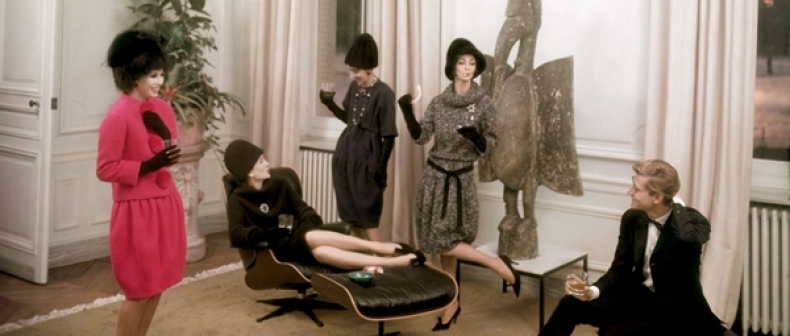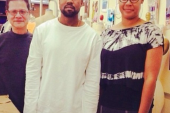
Image: Flickr
In the 1960s, fashion ignited its first true spark of rebellion and innovation. Social changes were sweeping the nation, both political and apolitical; youth culture was on the incline; designers began exploring more daring and bolder fashion choices — all of which pointed to a more demanding and thrill-seeking consumer audience than ever before. The public, decidedly, wanted to express themselves in new ways, so fashion became a means for social revolution and opposition — for transition.
As a result, we saw skirt hemlines rise (to much public outcry), female haircuts shorten (Ã la Twiggy), and designers like Yves Saint Laurent burst onto the scene, where he would eventually pioneer his signature Le Smoking tuxedo in the mid-1960s and forever alter how we think women should dress. Not to be missed, mod fashion arrived soon after, too, where an emphasis on the new and unknown emerged. So change was a-comin’, and fashion became as much a tool for change as a well-crafted political campaign.
From the 1970s onwards, this drive to break creative ground only grew. Halston brought in the halter and one-shouldered dresses, and Missoni introduced the zig-zag pattern. The 1980s saw bad fabrics and even worse silhouettes emerge; the 1990s, a sea of bland and minimalistic designs. But all this bad fashion (some good!) really wasn’t so bad after all: it meant change, expression, and a medium for risk-taking.
Flash to 2012, and the art of fashion seems to have lost its way. A sense of soulfulness and passion has slipped through the cracks and, instead, a mass-culture/capitalistic approach to style seems to have taken over. Newness has turned into novelty, which fizzles out one season to the next. Gone are the days of groundbreaking hemlines and designs; now is a sea of fast fashion and obnoxious reincarnations. Fashion is growing scarier by the second.
Designers, now, are faced with pressures to keep up with an impatient industry. More and more labels are being accused of running sweatshops and boot camp-like work conditions: Alexander Wang, in specific, has just been hit with a $50 million lawsuit by former employees, who allege they were forced to work 16-plus-hour days without overtime pay. Although Wang denies the accusations, it does make one wonder how designers and brands keep up with the high demand of their products. Do they sacrifice newness and compassion for mass sales — a quantity over quality, if you will?
Because of this increase in production, it’s also unsurprising that larger, mass retail chain figures are thriving, while luxury brands are struggling to stay afloat — a suggestion that the public wants more cheap and less frivolity. American Apparel, which has had its own sweatshop lawsuits in the past, is now reporting an 11 per cent rise in sales after a third month in a row of double-digit gains. On the flip side, the more upscale retailer Ann Taylor has marked a net income drop of 72.6 per cent. Last year, even the iconic blue boxes of Tiffany jewellery couldn’t entice buyers to spend: Tiffany shares fell 8.7 per cent, meanwhile brands Coach and Ralph Lauren dropped shares by 3 per cent, as well.
Amy Verner, The Globe and Mail‘s style reporter, says designers of the past didn’t have as much restrictions and pressures as designers face now: on top of being creative, designers must now think of marketability, competition, and accessibility without sacrificing their label’s integrity. “The whole notion of fast fashion just didn’t exist in the sixties. It wasn’t something that the designers had to even contend with,” says Verner. “There was designer, and then there was sort of just going into the department store.”
As a result of this push to sell, major fashion houses are now playing a never-ending game of musical chairs with their creative directors: both in hopes of re-inventing the look of their brand and creating new profit. In recent terms, Raf Simons was just booted from Jil Sander (rather, replaced by Sander herself), while Hedi Slimane made his triumphant return back to Yves Saint Laurent.
And although the brands may be in search of newness by this act of hiring and rehiring, which may suggest a brighter horizon for the world of design, Verner suggests profit still has a large stake in those final decisions.
“Ultimately, even with the most creative of creative processes, the whole goal is still to live products, is still to sell. It’s an interesting question because it kind of has to be both,” says Verner. “Only by virtue of creative process are you going to give people something to want. But you have to give them something that isn’t so radical that it will be beyond their frame of references… There is a very narrow window in which you have to be both creative and commercial, and I think any designer today has to be both.“
Just this past fall, ready-to-wear collections have shown in New York, Milan and Paris — and they seemed to offer a gleam of hope. This season saw much bolder collections from the top fashion houses: fanciful ornamentations at Louis Vuitton, multilayered pieces of art at McQueen, strips of crystal on the models’ eyebrows at Chanel. It appears fashion’s soul is slowly but surely clawing its way back from a post-recession slump.
“It was an interesting season — there was a lot more embellishment than the past seasons, it kind of feels like we are in that post-recessionary timeless look. We’re beyond that now,” says Verner. “Which is interesting, because, for so many seasons, it was about the investment piece and buying something that can really serve from season to season. And now all of this highly embellished ornamentation is not only very extensive but very specific. So it will be interesting to see how the stores buy that, how the buyers react to that, and then how consumers buy into that.”
Verner suggests fashion is also finding originality not through imitation, but through the deviation of classic materials and production.
“I think that what a lot of the designers are doing is they are minding the path for these classic shapes and references, but they are introducing really interesting fabrication. The newness is actually in a neoprene dress rather than the actual shape of the dress itself. Or fabrics that are bonded together, which means a fusing process as opposed to the classic stitching. There is newness within a past framework,” adds Verner. “I think that the designers who position their lines within that apocalyptic, dark, futuristic message – that doesn’t even feel ‘new.’ That just feels Mad Max or something. We’re not exactly seeing new, and we’re not going to know what new is until we see it.”
We’ll just have to wait and see.
Fashion is surely moving towards something big and new, it has to, but what that something is remains largely unknown. Will the ‘Occupy’ or ‘Kony 2012′ movements spark a ’60s-style, fashion-based social revolution? Unlikely. But glimpses of hope (and soul, yay for soul) are creeping back into an otherwise stagnant style scene: collections are breaking away from safer choices, street style blogs are once again encouraging the act of self-dressing and expression. The transition may take time, but fashion as a fully-realized art form is definitely worth waiting for.
________
Christian Allaire writes on style for Toronto Standard. Follow his tweets here: @chrisjallaire.
For more, follow us on Twitter @TorontoStandard and subscribe to our newsletter.














